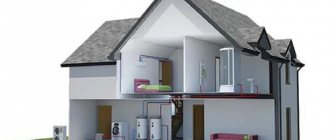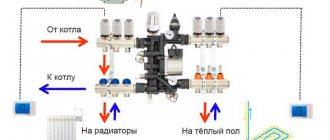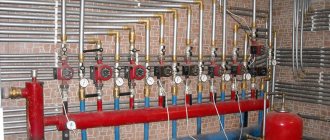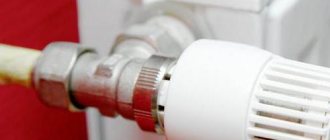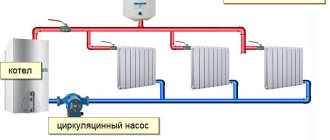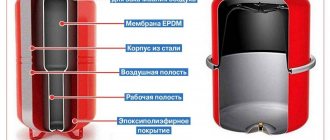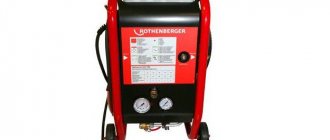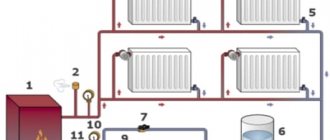Elevator unit of the heating system: what is it?
Three modes of operation of main heating networks are measured in degrees, they look like this:
- 95/70.
- 130/70.
- 150/70.
The first value refers to the supply temperature, and the second corresponding to the return pipe. Since the distance to boiler rooms is often quite large, energy loss occurs, forcing adjustments to the numbers taking into account the weather outside the window. These three options have been designed to save fuel consumption.
Purpose of the elevator unit
This important element in the system is designed to reduce pressure and normalize the temperature of the coolant. The process occurs by adding colder water from the heating circuit to the pipeline.
According to generally accepted sanitary standards, the liquid in radiators should not exceed 95 degrees; I will give a few obvious facts regarding this point:
- Extremely heated appliances in the apartment can harm a child after touching them.
- In this situation, cast iron radiators will become vulnerable to mechanical damage and fragile; aluminum radiators can fail.
- Plastic pipes used in room wiring are not designed to withstand very high temperatures and may lose their aesthetic appearance.
To prevent such excesses, an elevator is installed in the heating main; in apartment buildings it is impossible to do without such a part.
Device
Externally, this element looks like a kind of metal or cast iron structure with three holes, each of which has flanges for connecting the unit to the system. You should find out more about what the elevator unit consists of. The internal structure aroused much greater interest in me, initially I need to disassemble the components separately, it looks like this:
- Frame.
- Nozzle.
- Mixing chamber.
- Innings.
- Return line.
- Logout.
At the supply you can find the highest pressure, at the exit from the diffuser it is lower, and in the return system it is minimal; the same thing happens with the temperature of the liquid. The jumper, which is in a vertical position, cuts into the body at 90 degrees.
Schematic diagram of the elevator unit
A heating elevator will not be able to function productively without proper piping, although the device is quite simple and looks like a pump that supplies liquid under a certain pressure, but there are some nuances in this matter, I will analyze it more precisely.
The maximum heated water enters the inlet pipe and moves forward due to pressure. Thanks to the nozzle, an injection effect is created, which forces the liquid entering the receiving chamber to create a vacuum zone.
As the pressure decreases, water is sucked in from the pipe, which, in turn, is connected to the return pipeline. Due to these manipulations, the coolant enters the neck of the elevator and mixing of hot and cold flow begins.
Water, normalized taking into account all safety standards, is returned to the system through a diffuser and distributed to radiators located in apartments; this is what the diagram of an elevator heating unit looks like.
The principle of operation of the unit in the heating system
I believe that the operating principle of a heating elevator can be compared to a water pump, which operates without any external resources.
The design is quite simple and inexpensive, which is why most heating units use this element in multi-apartment building systems. But each unit must be operated properly; without certain conditions, interruptions in operation cannot be avoided.
The heating elevator has three holes with flanges for fastening, one of which is connected to the supply pipeline, the second is responsible for supplying liquid to the radiators, and the third receives the return flow. For proper operation of the network, it is necessary that the pressure difference between the supply and return flow exceed the hydraulic resistance of the heating system.
Elevator with automatic adjustment
I do not consider this type of device to be the most practical due to its dependence on external factors, but the device is quite modern and deserves attention. The design involves changing the nozzle cross-section through automatic adjustment.
How the elevator unit works is that it is connected to a mechanism specially designed for this process, which is located inside the elevator body. It is this component that is responsible for moving the throttle needle back and forth, depending on the temperature of the liquid in the system.
The moving element in the nozzle affects the clearance, as a result of which the coolant supply and its flow rate change. Changes in fluid permeability not only regulate the temperature in the pipes, but also the speed of movement of water in the heating system. This is due to a change in the coefficient when mixing cold and hot flow. I told you how the heating elevator circuit changes the temperature in the main pipe.
An equally important factor is that using an irreplaceable element, you can also regulate the pressure in the pipes and radiators of apartments.
The device directs the flow, creating changes in the coolant in the heating circuit. The design of the device involves the circulation of liquid, so it often comes with such successful additions as distribution units. In apartment buildings, such devices are necessary only because several consumers live in them.
A collector or comb is responsible for the distribution of water; after entering this container, the coolant from the automatic elevator unit goes through the residents’ rooms through many exits. Such manipulation does not affect the pressure in the system; it remains the same.
Elevator what is it
To understand and understand what this element is, it is best to go down to the basement of the building and see it with your own eyes. But if you have no desire to leave your home, then you can view the photo and video files in our gallery. In the basement, among the many gate valves, pipelines, pressure gauges and thermometers, you will definitely find this unit.
We suggest first understanding the principle of operation. Hot water is supplied to the building from the district boiler house, and cooled water is discharged.
This requires:
- Supply pipeline
– supplies hot coolant to the consumer; - Return pipeline
- performs the work of removing the cooled coolant and returning it to the district boiler room.
Several houses, and in some cases each one if the houses are large, are equipped with thermal chambers. They distribute coolant between houses, and also install shut-off valves that serve to cut off pipelines. Drainage devices can also be installed in the chambers, which are used to empty pipes, for example, for repair work. Further, the process depends on the temperature of the coolant.
In our country there are several main modes of operation of district boiler houses:
- Supply 150 and return 70 degrees Celsius;
- Respectively 130 and 70;
- 95 and 70.
The choice of mode depends on the latitude of residence. So, for example, for Moscow a 130/70 schedule will be sufficient, but for Irkutsk a 150/70 schedule will be needed. The names of these modes have the numbers of the maximum load of the pipelines. But depending on the air temperature outside the window, the boiler room can operate at temperatures of 70/54.
This is done to prevent overheating in the rooms and to make them comfortable to stay in. This adjustment is performed at the boiler room and is a representative of the central type of adjustment. An interesting fact is that in European countries a different type of regulation is performed - local. That is, adjustment takes place at the heat supply facility itself.
In this case, heating networks and boiler houses operate at maximum capacity. It is worth saying that the highest performance of boiler units is achieved precisely at maximum loads. comes to the consumer and is locally regulated by special mechanisms.
These mechanisms consist of:
- Outdoor and indoor temperature sensors;
- Servo drive;
- Actuator with valve.
Such systems are equipped with individual devices for metering thermal energy, thereby achieving great savings in monetary resources. Compared to elevators, such systems are less reliable and durable.
So, if the coolant has a temperature of no more than 95 degrees, then the main task is the high-quality physical distribution of heat throughout the system. To achieve these goals, manifolds and balancing valves are used.
But in the case when the temperature is above 95 degrees, it needs to be reduced a little. This is what elevators do in the heating system; they add chilled water from the return line to the supply pipeline.
Important. The process of adjusting the elevator unit is the simplest and cheapest mechanism; the main thing is to correctly calculate the heating elevator.
Features and Specifications
As we have already figured out, the elevator of the heating system is responsible for cooling the superheated water to a given value. This prepared water then enters.
This element improves the quality of operation of the entire building system and, when properly installed and selected, performs two functions:
- Mixing;
- Circulation.
Advantages of the elevator heating system:
- Simplicity of design;
- High efficiency;
- No electrical connection required.
Flaws:
- We need accurate and high-quality calculation and selection of a heating elevator;
- There is no way to regulate the outlet temperature;
- It is necessary to maintain a pressure difference between supply and return of around 0.8-2 bar.
Nowadays, such elements have become widespread in heating networks. This is due to their advantages, such as resistance to changes in hydraulic and temperature conditions. In addition, they do not require constant human presence.
Important. Calculation, selection and configuration of elevators should not be done with your own hands; this matter is best left to specialists, since a selection error can lead to big problems.
Design
The elevator consists of:
- Vacuum chambers;
- Nozzles;
- Jet elevator.
Among heating engineers there is a concept called piping an elevator unit. It consists of installing the necessary shut-off valves, pressure gauges and thermometers. All this is assembled and is a unit.
Important! Today, manufacturers sell elevators that, thanks to an electric drive, can adjust the nozzle. At the same time, it is possible to adjust the coolant flow automatically. But it is also worth noting that such equipment does not yet have a high degree of reliability.
Flaws
The design of the thermal unit and the device itself, despite all its positive aspects, has disadvantages, which include the following:
- The dimensions of the device components are quite difficult to calculate, but if this is not done, then maximum productivity will not be ensured.
- When ensuring a pressure difference between two lines, it is necessary to adhere to an indicator not exceeding 2 Bar.
- For regulation it is necessary to equip the unit with an electric drive.
To control the temperature, you will need to change the diameter of the nozzle, but not all models of the device are equipped with such devices; I consider this the main problem in the operation of the elevator unit of the heating system.
The role of the elevator unit
Heating of domestic apartment buildings is carried out through a centralized heating system. For this purpose, small thermal power plants and boiler houses are being built in small and large cities. Each of these objects produces heat for several houses or neighborhoods. The disadvantage of such a system is significant heat loss.
If the coolant path is too long, it is impossible to regulate the temperature of the transported liquid. For this reason, every home must be equipped with an elevator unit. This will solve many problems: it will significantly reduce heat consumption, and prevent accidents that may occur as a result of power failure or equipment failure.
This issue becomes especially relevant in the autumn and spring periods of the year. The coolant is heated in accordance with established standards, but its temperature depends on the outside air temperature.
Thus, the nearest houses, compared to those located further away, receive hotter coolant. It is for this reason that the elevator unit of the central heating system is so necessary. It will dilute the overheated coolant with cold water and thereby compensate for heat loss.
Technical characteristics of standard models
Factory copies have 7 types of designs, differing in size, each of them has its own special number. To successfully select a good option and avoid problems during crimping, it is worth considering two parameters - the diameter of the mixing chamber and the nozzle.
With the second component the situation is simpler; it can be replaced if necessary, because the body is removable. Such actions are resorted to in 2 options:
- Wear of a part after a certain time (wear and tear due to abrasive particles).
- Changes in the mixing ratio, which is necessary to increase or decrease the temperature of the coolant.
I learned an interesting fact about the operation of the elevator unit: often in the technical specifications there is no point that introduces the buyer to the nozzle cross-section; the diameter is calculated separately. The main attention is focused on the mixing and injection chamber in order to accurately calculate the size for a specific heating system.
Kinds
There are two types of these devices:
- Elevators that cannot be regulated.
- Elevators, the operation of which is controlled by an electric drive.
When installing any of them, it is very important to maintain tightness. This equipment is installed in a heating system that is already functioning. Therefore, before installation, it is recommended to study the location where the subsequent placement of this equipment is planned. It is recommended to entrust this type of work to specialists who are able to understand the scheme, as well as develop drawings and perform calculations.
The operating principle of a thermal elevator unit and a water-jet elevator.
In the previous article, we found out the basics and operating features of water-jet or, as they are also called, injection elevators. In short, the main purpose of the elevator is to lower the water temperature and at the same time increase the volume of pumped water in the internal heating system of a residential building.
Now let’s look at how a water jet elevator actually works.
and due to which it increases the pumping of coolant through the batteries in the apartment.
The coolant enters the house at a temperature corresponding to the temperature schedule of the boiler room. Temperature chart
this is the relationship between the temperature outside and the temperature that the boiler house or thermal power plant must supply to the heating network, and accordingly, with small losses, to your heating point (water, moving through pipes over long distances, cools down a little). The colder it is outside, the higher the temperature the boiler room produces.
For example, with a temperature chart of 130/70:
- at +8 degrees outside, the heating supply pipe should be 42 degrees;
- at 0 degrees 76 degrees;
- at -22 degrees 115 degrees;
If anyone is interested in more detailed figures, you can download temperature charts for various heating systems.
But let’s return to the principle and operating diagram of our thermal elevator unit.
After passing through the inlet valves, mud traps or mesh magnetic filters, the water enters directly into the mixing elevator device - the elevator
, which consists of a steel body, inside of which there is a mixing chamber and a restriction device (nozzle).
Superheated water comes out of the nozzle at high speed. As a result, a vacuum is created in the chamber behind the jet, due to which water is sucked in or injected from the return pipeline. By changing the diameter of the hole in the nozzle, you can regulate the water flow
and, accordingly, the temperature of the water leaving the elevator.
The elevator of the thermal unit works simultaneously as a circulation pump and as a mixer. At the same time, it does not consume electrical energy
, but uses the pressure drop in front of the elevator or, as is commonly said, the available pressure in the heating network.
For the elevator to operate efficiently, it is necessary that the available pressure
in the heating network was related to the resistance of the heating system
no worse than 7 to 1
. If the resistance of the heating system of a standard five-story building is 1 m or 0.1 kgf/cm2, then for normal operation of the elevator unit the available pressure in the heating system up to the ITP is at least 7 m or 0.7 kgf/cm2.
For example, if in the supply pipeline there is 5 kgf/cm2, then in the return pipeline there is no more than 4.3 kgf/cm2.
Please note that at the elevator outlet the pressure in the supply line is not much greater than the pressure in the return line
and this is normal, 0.1 kgf/cm2 is quite difficult to notice on pressure gauges, the quality of modern pressure gauges is unfortunately at a very low level, but this is a topic for a separate article. But if you have a pressure difference after the elevator of more than 0.3 kgf/cm2, you should be wary, or your heating system is heavily clogged with dirt, or during a major overhaul the diameters of the distribution pipes were greatly underestimated.
The above does not apply to circuits with batteries and risers; only mixing circuits using control valves and mixing pumps work with them. By the way, the use of these regulators is also very controversial in most cases, since most domestic boiler houses use high-quality regulation according to the temperature schedule
. In general, the mass introduction of automatic regulators became possible only thanks to good marketing; this is a very rare phenomenon in our country; usually we do not receive enough heat.
Calculation and selection of elevator
Guided by special formulas, first of all, you need to calculate the diameter of the mixing chamber, then select the required number of the heating elevator, after which the size of the nozzle is determined. Unknown kilocalories should be immediately converted into common units; they are often converted to Bar.
The narrow part of the elevator nozzle is calculated in millimeters; there is also a formula for this process. The calculations were not difficult for me, although when looking at the notebook, all the operations seemed huge. Having calculated the pressure at the outlet from the central line, it is worth applying an alternative formula to determine the diameter. But I want to point out that the result will be expressed in centimeters.
Installation of an elevator into the system
This device is most often located in the basement of the house, but before starting installation-related manipulations, the room is checked for such nuances as:
- No temperature drop below 0 degrees Celsius.
- The room must be covered.
- The presence of exhaust ventilation, since after condensation forms on the pipes, the unit will quickly fail.
Models with built-in automatic mechanisms require an uninterrupted supply of electricity, so without installing an independent power source, such equipment will be unsafe.
When the supply of a resource important for operation is turned off, the temperature control process should not stop, otherwise a lot of unpleasant moments will occur, and to avoid voltage drops, it is necessary to install a condensation rectifier.


